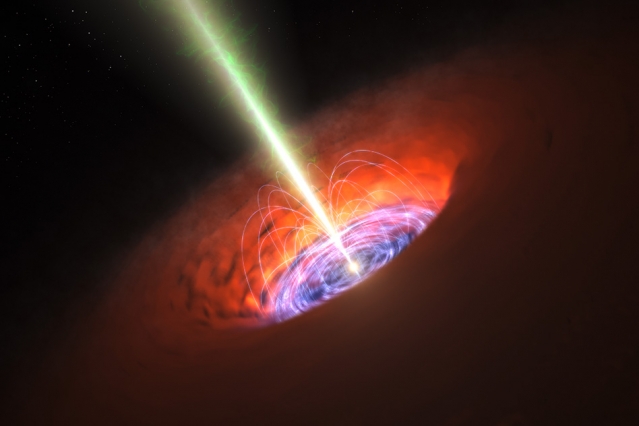A Hungry Black Hole Devoured a Star, and Its 'Burp' Reveals How It Chowed Down

A black hole that's gobbling down a stellar meal is providing insight into how black holes devour matter and affect the evolution of galaxies.
Researchers found that the X-ray signal burst caused when a black hole shredded a passing star was repeated in the radio wavelengths nearly two weeks later. The radio echo most likely came from an exodus of highly energetic particles streaming out of the black hole, the researchers said.
In 2014, Las Cumbres Observatory's All-sky Automated Survey for Supernovae, a collection of robotic telescopes spread across the globe, picked up signals from 300 million light-years away. The event, known as ASASSN-14li, occurred as a star was ripped to shreds after passing too close to a black hole. Multiple telescopes immediately turned to track the tidal disruption flare, a powerful explosion of electromagnetic energy caused by the destruction. After poring through about six months' worth of data, Dheeraj Pasham, a researcher at the Massachusetts Institute of Technology, and Sjoert van Velzen, of Johns Hopkins University, found a pattern in the radio wavelength that nearly duplicates the X-ray signal. [No Escape: Dive Into a Black Hole (Infographic)]
"This is telling us the black hole feeding rate is controlling the strength of the jet it produces," Pasham said in a statement. "A well-fed black hole produces a strong jet, while a malnourished black hole produces a weak jet or no jet at all. This is the first time we've seen a jet that's controlled by a feeding supermassive black hole."
Not a coincidence
When a star passes too close to a black hole, the enormous mass of the black hole exerts a tidal tug on the star. The forces are so strong that they can stretch and flatten the star, eventually tearing it to pieces. The stellar debris falls toward the black hole, where it is caught in the accretion disk, the collection of material that feeds the black hole. This is what happened in the case of ASASSN-14li.
The feeding process generates enormous energy visible in multiple wavelengths. Flares have been observed around other black holes in optical, ultraviolet, X-ray and radio wavelengths. As ultrahot material in the innermost regions of the accretion disk funnels toward the black hole, it produces X-ray emissions, while material farther out produces optical and ultraviolet emission. The source of radio emissions, however, has remained unknown.
"We know that the radio waves are coming from really energetic electrons that are moving in a magnetic field — that is a well-established process," Pasham said. "The debate has been, where are these really energetic electrons coming from?"
Get the Space.com Newsletter
Breaking space news, the latest updates on rocket launches, skywatching events and more!
One possibility is that, in the moments following the stellar explosion, a shock wave moves outward, energizing the plasma particles and causing them to emit radio waves. These radio waves would look dramatically different from the pattern of X-rays created by the infalling stellar material. But the signal Pasham and Van Velzen found in the radio is a 90-percent match with the X-ray signal.
"What we found basically challenges this paradigm," Pasham said.
The close match suggests that the sources responsible for creating the radio waves and X-rays are related.
"It's not a coincidence that this is happening," Pasham said. "Clearly there's a causal connection between this small region producing X-rays and this big region producing radio waves."
The pair proposes that the radio waves are created by high-energy particles streaming out of the black hole soon after the behemoth begins to absorb material from the shredded star. Because the radio waves formed in a region tightly packed with other electrons, most of the signal was absorbed by those particles, the researchers said. The electrons responsible for the radio signal could escape only when they traveled downstream of the jet, producing the signal the scientists detected.
The researchers concluded that the strength of the jet must be controlled by the accretion rate, or the speed at which the black hole is consuming the stellar debris responsible for emitting X-rays.
The new observations, which were published March 19 in The Astrophysical Journal, may help scientists better characterize the physics of jet behavior. This, in turn, may help improve researchers' understanding of how galaxies evolve.
Galaxies grow by producing new stars, but they can only do so under very cold temperatures. Jets emitted by black holes heat up the surrounding galaxies, temporarily halting stellar births. Pasham said the team's new insight into jet production and black-hole accretion may help to simplify models of galaxy evolution.
"If the rate at which the black hole is feeding is proportional to the rate at which it's pumping out energy, and if that really works for every black hole, it's a simple prescription you can use in simulations of galaxy evolution," Pasham said. "So this is hinting toward some bigger picture."
Follow Nola Taylor Redd at @NolaTRedd, Facebook, or Google+. Follow us at @Spacedotcom, Facebook or Google+. Originally published on Space.com.
Join our Space Forums to keep talking space on the latest missions, night sky and more! And if you have a news tip, correction or comment, let us know at: community@space.com.

Nola Taylor Tillman is a contributing writer for Space.com. She loves all things space and astronomy-related, and enjoys the opportunity to learn more. She has a Bachelor’s degree in English and Astrophysics from Agnes Scott college and served as an intern at Sky & Telescope magazine. In her free time, she homeschools her four children. Follow her on Twitter at @NolaTRedd









